Fan Palm With Leaf Blight From the Pathogen Bipolaris incurvata
Palm Tree Problems
Palm tree problems are something you want to solve as early as possible. It’s not fun to worry that something is threatening your palm! Especially after investing money in its purchase and ongoing care.
They face Attacks by Diseases, by Insects, & from Weather. There may be other concerns you have for dealing with some problems with palm trees.
We’ll check into the various problems palm trees may run into. Move along through our page to see them. Or Click Below to Check for your concern.
Symptom Diagnosis For Palm Tree Problems
Using visible symptoms to diagnose palm tree problems you see is not always reliable. Many symptoms are caused by multiple possibilities. Yet it is the quickest, cheapest way to get to the possible problem.
FTC Disclosure: If you purchase via a link/ ad on this site, we may earn a small royalty. There’s no added cost to you. Thanks much for any looks/ orders! Details>
What you can do is look at the symptom, and see which problems for palm trees might suit the situation. Getting help from Palm Horticulture Books is quite helpful, too.
One we really like is called Ornamental Palm Horticulture. It’s very useful for learning so much about palm trees. Plus it has lots of good photographs for added assistance to help diagnose problems.
If need be, then you can get professional help.
Meanwhile, we have hints to get you started:
- WILTING – Possible problems: watering too much OR too little, root rot, or nutrient deficiency.
- FRONDS WITH BROWN SPOTS – Potential sign for fungal problem, nutrient deficiency, or pest attack. You’d want to get right to knowing the Palm Tree Care for Brown Leaves! Freezing Cold Damage also causes this problem.
- LEAF YELLOWING – Common symptom for many palm tree problems. Called chlorosis. Could be nutrient deficiency, overwatering, or problem pests.

Browning Frond Leaflets Indicate Problems

Chlorosis is leaf yellowing, as seen in this Palm Frond.
- TRUNK/STEM CRACKS/HOLES – Cracks can happen in old age, or with wind damage. But pests can do this damage. Especially Scale or Borers can drill holes.
- SAGGING FRONDS – Remember some fronds naturally limp downward. But if it’s a change, it could be from too little or too much water, or a serious nutritional need.
- DEAD/DYING LEAF PARTS – It naturally happens with old fronds. But also with over/under watering, or with various pest infestations.
Palm Tree Pests and Diseases
Nothing throws a loop into your palmy heart like finding something wrong with your palm tree. Teeny bugs crawling around, or odd colors on the fronds. Or things oozing out, reminding you of some horror end-of-the-world film!
We’ll look at the most common palm tree problems caused by Palm Pests and Diseases for ornamental palms you’d be growing yourself.
COMMON PALM PESTS
These pests damage palms in various ways. By carrying disease germs, chewing into fronds, feeding on palm sap, or by tunneling into essential Palm Parts.
INSECTS – Scientifically classified as Insecta.
- Scales – Tiny squooshy bugs that cover themselves in waxy brown, gray or white disguises. Their true color underneath is brighter. They harm plants by sucking out juices or cell contents.
- Mealybugs – Very small, with oblong shape. White waxy covering with wax projections are all over their bodies. Usually found near the leaf base. They like sweet plant juices.

Infestation of Mealybugs
- Weevils – Small snout beetles. Name describes them well. Antennae on either side of their snout.

- Thrips – Teeniest narrow winged pest. Nymphs & adults do the damage. Roughing up the underneath surfaces of palm fronds. Feed on the oozing sap.
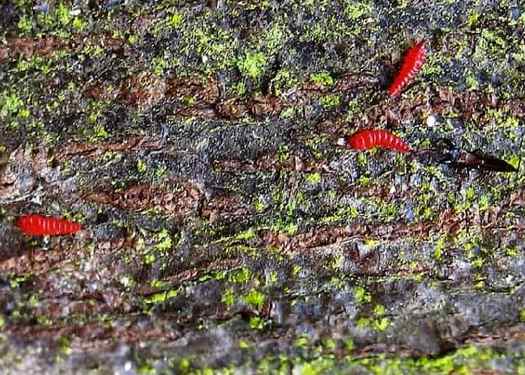
Thrips, scientifically named Ecacanthothrips tibialis, Feed on Fungi of Dead & Dying Plant Matter
- Spider Mites – Another insect that sucks out palm sap. Robbing palm plants of their “life blood.” Tiny white webbing areas hint that they’re a problem. Injured fronds show spots. They can be a problem for Potted Palm Plants. Inspect the underside of indoor palms regularly.
Wormy looking parasites, in the scientific Phylum Nematoda. Often called roundworms because of their appearance.
- Most commonly carried by Palm Weevils, especially Rhynchophorus palmarum.
- Other vector carriers are Burrowing, Root-rot, Reniform, Lesion, Spiral & Stunt Nematodes.
PALM TREE DISEASES
ALGAE DISEASES – Shady humid areas with lots of moisture promote these. Most algae are harmless. If unsightly can be wiped away from attacked leaves.
Filamentous green algae is the rare type that can cause frond destruction.
OOMYCOTA DISEASE – Only from the Genus Phytophthora.
- Sometimes seen are Spot & Blight diseases. Also Container Root & Petiole Rots, and Damping-off.
- But the most common is Lethal Bud Rot.
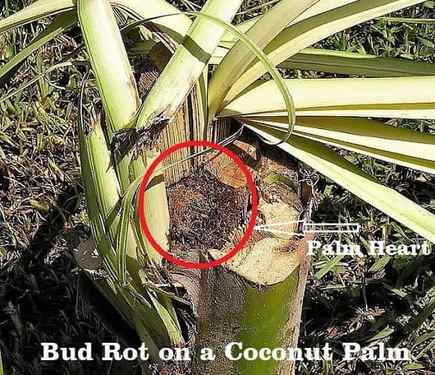
When the Palm Bud Dies, the Palm Tree Dies!
FUNGAL DISEASE – Many afflict Types of Potted Palms . Although some fungal species affect outdoor landscape palms.
Multiple species can be affected, but more susceptible for Damping-Off with young palms.
A Palm Tree Fungus Spray is often a solution.
FUNGUS SPRAY
Possible Fungal Diseases:
- Root & Pink Rot – Common for Container Palms without good drainage. Symptomatic wilting or pink coloration are indications.
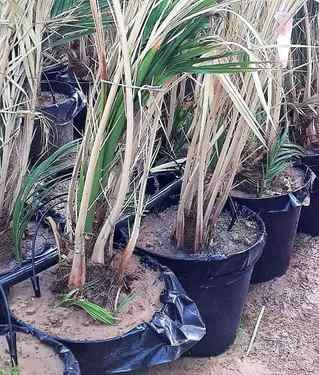
Young Palms in Pots Lined With Plastic Sheeting
Allowing No Soil Drainage, Giving Rise to Rot Fungus
- Trunk Rot – Specifically a Palm Tree Trunk Fungus. Two pathogen species hit palms. Attacking lignin, the rebar-like strength fibers within a trunk.
- First symptoms are white lumpy bumps (conks) growing from the trunk’s bottom, which enlarge & turn brownish.
- Spores can contaminate other palms.
- Trunk bottom will soften from the inside, eventually falling over.
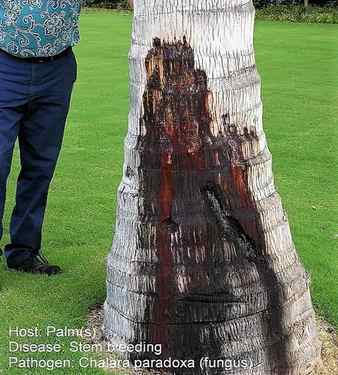
- Leaf Spots – Multiple species around to cause these palm tree problems. Watch for yellow (chlorotic) areas. Then turning brown & developing a dark ring around the edge.
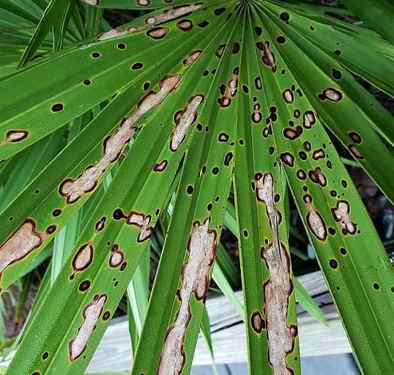
Leaf Spot Fungus – Possibly Caused by a Bipolaris Species
- Blights – Affect Specific Parts of Fronds, the rachis or petiole. Typically not deadly, but doesn’t look very nice! Because blight turns leaflets, segments & stems brownish.
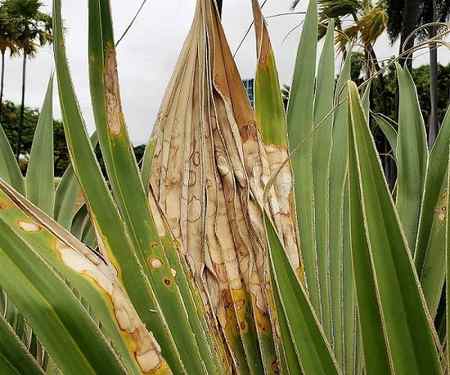
Fan Palm With Leaf Blight From the Pathogen Bipolaris incurvata
- Fusarium Wilt – Four pathogens that block water flow within a palm. It causes death, as you can imagine. Initial symptoms can look like blight.
- But fronds usually begin to die, from the canopy’s bottom, then upward.
- Distinctively, feather fronds fully brown on one side of the rachis.
VIRAL DISEASE – Because of regulations, so far restricted to South American palm oil production facilities, Southeast Asia & South Pacific Countries. Two disease strains. Haven’t been problematic to Ornamental Palms.
PROTOZOAN DISEASE – Carried by a True Bug vector in Central & South American tropics. Causes lethal wilts.
PHYTOPLASMA DISEASE – Problematic bacteria with no cell wall. Carried mostly by these vectors from the order Hemiptera: leafhoppers, planthoppers or psyllids. Primarily causes Lethal Yellowing. Mostly seen in the Southeastern US & Caribbean.
OTHER BACTERIAL DISEASES – Uncommonly seen, causing Bud Rot.
Covering palm tree trunks in paint
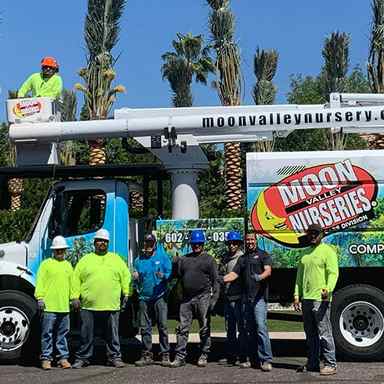
Weather Protection
We’re subjected to mild and brief winter periods with a slight chance of freezing temperatures. Our summers can reach sustained periods of extreme heat, sometimes lasting for months, and are accompanied with the occasional monsoon. Our spring and fall seasons are rather pleasant and ideal for planting. Our intimate plant knowledge has enabled us to select certain species of trees and plants that will survive and thrive under these conditions. Some species will require more monitoring and caring than others, but this is a general guide for just about any tree or plant we carry at our nurseries.
Weather Protection
We’re subjected to mild and brief winter periods with a slight chance of freezing temperatures. Our summers can reach sustained periods of extreme heat, sometimes lasting for months, and are accompanied with the occasional monsoon. Our spring and fall seasons are rather pleasant and ideal for planting. Our intimate plant knowledge has enabled us to select certain species of trees and plants that will survive and thrive under these conditions. Some species will require more monitoring and caring than others, but this is a general guide for just about any tree or plant we carry at our nurseries.
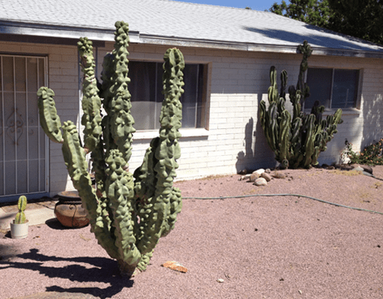
CLICK HERE to learn How to Prepare your Yard for Cooler Weather
Frost and Freeze Protection
Frost or Freeze conditions are pretty rare in our area, and unlike most areas in the country, they don’t occur every year. Frost conditions, nights where temperatures reach below freezing (32F°) usually occurs January through middle to late February. Temperatures below freezing can cause damage to certain varieties of trees and shrubs that are not commonly grown in the area. If you have questions on the hardiness of your plants or how cold your particular area gets before purchasing new trees and plants, just ask your nearest Moon Valley Nursery. Smaller and newly planted trees and shrubs tend to be the most susceptible to damage from cold weather. All trees and plants can benefit from the following measures to help prevent damage from frost & freezing conditions:
The laws of thermodynamics prove that it is more difficult to cool humid air than dry air, so be sure to thoroughly water all of your trees and plants during periods of forecast frost or freeze. Also, get your entire yard wet in the evening before forecast/ freeze. This boosts the humidity in the immediate microclimate and will help minimize the effects of frost/ freeze on your trees and plants.
Cover with Frost Cloth
Where feasible, cover plants with a frost cloth or old blankets before a night forecast to bring a freeze. Don’t use plastic – plastic increases the chance of freeze damage. For larger trees and plants, you can apply Frost Proof insulating spray. This applies a thin layer of a wax-like substance that minimizes evaporation from the leaves, thus minimizing frost/freeze damage. Frost Cloth & Frost Proof spray are available at all Moon Valley Nurseries.
People have had success in preventing frost/freeze damage by stringing up Christmas lights in their trees. The older style lights (incandescent) provide the best warming effect. It may sound silly, but a few degrees can make a huge difference. There are other popular methods of protecting against freeze damage, but due to the unpredictable and uncontrollable nature of weather, they aren’t guaranteed to work.





